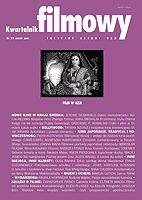Puste miejsca: Kino Kiyoshi Kurosawa
Empty Places: the Cinema of Kiyoshi Kurosawa
Author(s): Andrzej PitrusSubject(s): Theatre, Dance, Performing Arts
Published by: Instytut Sztuki Polskiej Akademii Nauk
Keywords: Kurosawa Kiyoshi; Japan
Summary/Abstract: Kurosawa, the Japanese niche film director who debuted in 1983, produced peculiar mostly TV gangster films often combining elements of drama and comedy." Cure" (Kyua 1997), considered to be a landmark film in the career of Kurosawa, not only departed from the B-picture cinema but also introduced elements of his individual cinematic language. Cure defined Kurosawa’s visual style based on long takes, accentuating the importance of emptiness. The director of "Pulse" ("Kairo" 2001), "Serpent’s Path" ("Hebi no michi' 1998), "Eyes of the Spider" ("Kumo no hitomi" 1998), "Seance" ("Korei" 2000) and "Doppelgänger" ("Dopperugengâ" 2003) introduces narration solutions arbitrarily; uses ellipses that challenge the logic of cause and effect; he is more interested in characters facing the ultimate challenges than in the story itself. Although Kurosawa has abandoned making B-picture films, he continues to draw on the cinema of “genres”. His movies are not uniform but combine elements of various film conventions (thriller, melodrama and comedy). Popular film conventions are the pretext for reflections that go beyond film commercialism. Kurosawa also follows the “alternative path” to which Pitrus numbers "License to Live" ("Ningen gokaku" 1998), "Charisma" ("Karisma" 1999) and "Bright Future" ("Akarui mirai' 2003).
Journal: Kwartalnik Filmowy
- Issue Year: 2005
- Issue No: 51
- Page Range: 182-189
- Page Count: 8
- Language: Polish

